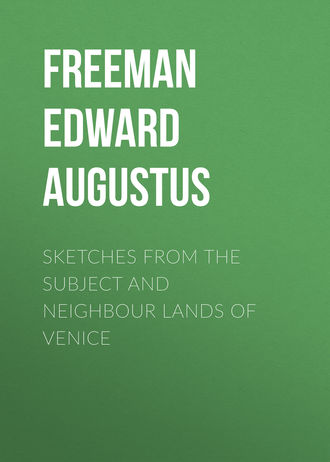
Freeman Edward Augustus
Sketches from the Subject and Neighbour Lands of Venice

TOWER OF ST. MARY'S ZARA.
But Saint Anastasia is not the only, it is hardly the most interesting, church in Zara. Saint Chrysogonos, monk and martyr, was held in reverence at Diadora in the days of Constantine, where his tomb and his holy chain were to be seen. Perhaps they are to be seen still; certainly his name is still preserved in an admirable church of the same general Lucchese type as the duomo, but which surpasses it in the exquisite grace of the three apses at its east end, after the best models of the type common to Italy and Germany. Within, the arrangement of the triapsidal basilica is perfect; the range of columns is, as is so often found, interrupted by two pairs of more massive piers, making groups of three, two, and two arches. It is almost startling to find that the date of the consecration of this exquisite Romanesque church is as late as 1407; but the fact is only one example out of many of the way in which in some districts, in Dalmatia above all, the true style of the land stood its ground. In Dalmatia the Italian pseudo-Gothic, common in houses, is but little seen in churches at any time. Another church, Saint Simeon, called after the Prophet of Nunc dimittis, boasts of its gorgeous shrine borne aloft behind the high altar, the gift of Elizabeth of Bosnia, the wife of Lewis the Great. The church itself is of the same basilican type as the other, but in less good preservation. Saint Mary's, a church of nuns, is itself of a rather good kind of Renaissance, but its chief merit is that it keeps the only finished ancient tower in Zara, a noble campanile of the best Italian type, thick with midwall shafts, which every Englishman will feel to be the true kinsman of our own towers at Lincoln and Oxford. Its date is known; it is the work of King Coloman of Hungary, in 1105. But, after all, the most interesting architectural work in Zara is one which, as far as we have seen, is not noticed in any English book, but which was described by the Imperial pen in the tenth century, and which has in our own days been more fully illustrated in the excellent work of Eitelberger on the Dalmatian buildings. Close by Saint Anastasia there stood in the days of Constantine, and there still stands, a round church, lately desecrated, now simply disused, which was then called by the name of the Trinity (ἕτερος ναὸς πλησίον αὐτοῦ εἰληματικὸς, ἡ ἁγία Τριάς ), but which now bears that of Saint Donatus. Its dome and the tower of Saint Mary's are the two objects which first catch the eye in the general view of Zara. Tradition, as usual, calls the building a pagan temple, in this case of Juno; but it has in no way the look of a temple, nor does the Emperor who describes it with some minuteness give any hint of its having been such. Yet it is plain that, if it was not itself a pagan building, the spoils of pagan buildings contributed to its materials. Formed of two arcaded stages, the whole pile rises to a vast height, and the height of the lower stage alone is very considerable. The arches of the round rest on heavy rectangular piers of truly Roman strength, save only two vast columns with splendid Composite capitals – which mark the approach to the triapsidal east end. This building, lately cleared from the disfigurements and partition of its profane use, forms one of the noblest round churches to be found; the so-called house of Juno at Zara is almost a rival of the so-called house of Jupiter at Spalato. The upper stage is of the same general type as the lower, having again two columns left free and uninjured, but not rivalling the splendour of those which are in bondage below. Zara had lately another desecrated church of extreme interest, but of quite another type from Saint Donatus. This was the little church of Saint Vitus, a perfect example of the genuine Byzantine arrangement on a very small scale. The ground-plan was square; four arms, square-ended without, quasi-apsidal within, bore up the cupola on perfectly plain square-edged piers. Between our first and second visits to Zara, between 1875 and 1877, this charming little piece of Byzantine work was swept away to make a smart shop-front. It was a recompense no more than was due to find on our third visit that the round church had been cleared out.

SAINT VITUS, ZARA, AND THE ORTHODOX CHURCH, CATTARO.
Such is Zara, a city in which, as at Parenzo, the ecclesiastical element distinctly prevails, as contrasted with the mainly pagan interest of Pola. Such is equally the case in our next Dalmatian city also. But the main interest of Sebenico is of a different kind from that of any of its fellows. We go there to study a church, but, as we have seen, a church which has little in common with other churches in Dalmatia or anywhere else. At Zara, at Spalato, at Ragusa, we study buildings which all in some sort hang together. At Sebenico we stop our course to study something which stands altogether aloof from all.
SPALATO AND ITS NEIGHBOURS
SPALATO
1875
The main object and centre of all historical and architectural inquiries on the Dalmatian coast is of course the home of Diocletian, the still abiding palace of Spalato. From a local point of view, it is the spot which the greatest of the long line of renowned Illyrian Emperors chose as his resting-place from the toils of warfare and government, and where he reared the vastest and noblest dwelling that ever arose at the bidding of a single man. From an œcumenical point of view, Spalato is yet more. If it does not rank with Rome, Old and New, with Ravenna and with Trier, it is because it never was, like them, an actual seat of empire. But it not the less marks a stage, and one of the greatest stages, in the history of the Empire. On his own Dalmatian soil, Docles of Salona, Diocletian of Rome, was the man who had won fame for his own land, and who, on the throne of the world, did not forget his provincial birthplace. In the sight of Rome and of the world Jovius Augustus was more than this. Alike in the history of politics and in the history of art, he has left his mark on all time that has come after him, and it is on his own Spalato that his mark has been most deeply stamped. The polity of Rome and the architecture of Rome alike received a new life at his hands. In each alike he cast away shams and pretences, and made the true construction of the fabric stand out before men's eyes. Master of the Roman world, if not King, yet more than King, he let the true nature of his power be seen, and, first among the Cæsars, arrayed himself with the outward pomp of sovereignty. In a smaller man we might have deemed the change a mark of weakness, a sign of childish delight in gewgaws, titles, and trappings. Such could hardly have been the motive in the man who, when he deemed that his work was done, could cast away both the form and the substance of power, and could so steadily withstand all temptations to take them up again. It was simply that the change was fully wrought; that the chief magistrate of the commonwealth had gradually changed into the sovereign of the Empire; that Imperator, Cæsar, and Augustus, once titles lowlier than that of King, had now become, as they have ever since remained, titles far loftier. The change was wrought, and all that Diocletian did was to announce the fact of the change to the world. So again, now that the Roman city had grown into the Roman world, a hill by the Tiber had long ceased to be a fit dwelling-place for rulers who had to keep back hostile inroads from the Rhine and the Euphrates. This fact too Diocletian announced to the world. He planted his Augusti and his Cæsars on spots better suited for defence against the German and the Persian than the spot which had been chosen for defence against the Sabine and the Etruscan. Jupiter of the Capitol and his representatives on earth were to be equally at home in every corner of their dominions. Nor is it wonderful if, with such aims before him, he deemed that a faith which taught that Jupiter of the Capitol was a thing of naught was a faith which it became his votary to root out from all the lands that bowed to Jove and to Jovius. What if his work in some sort failed? what if his system of fourfold rule broke up before his own eyes – if his Bithynian capital soon gave way to the wiser choice of a successor, if the faith which he persecuted became, almost on the morrow, the faith of his Empire? Still his work did not wholly fail. He taught that Empire was more than kingship, a lesson never forgotten by those who, for fifteen hundred years after him, wore the diadem of Diocletian rather than of Augustus. In some sort he founded the Roman Empire. What Constantine did was at once to undo and to complete his work by making that Empire Holy.
Such a man, if not actually a creator, yet so pre-eminently one who moulded the creations of others into new shapes, might well take to himself a name from the supreme deity of his creed, the deity of whom he loved to be deemed the special votary. The conception which had grown up in the mind, and had been carried out by the hand, of the peasant of Salona might well entitle him to his proud surname. Nor did the organizing hand of Jovius confine its sphere to the polity of the Empire only. He built himself an house, and, above all builders, he might boast himself of the house that he had builded. Fast by his own birthplace – a meaner soul might have chosen some distant spot – Diocletian reared the palace which marks a still greater epoch in Roman art than his political changes mark in Roman polity. On the inmost shore of one of the lake-like inlets of the Hadriatic, an inlet guarded almost from sight by the great island of Bua at its mouth, lay his own Salona, now desolate, then one of the great cities of the Roman world. But it was not in the city, it was not close under its walls, that Diocletian fixed his home. An isthmus between the bay of Salona and the outer sea cuts off a peninsula, which again throws out two horns into the water to form the harbour which has for ages supplanted Salona. There, not on any hill-top, but on a level spot by the coast, with the sea in front, with a background of more distant mountains, and with one peaked hill rising between the two seas like a watch-tower, did Diocletian build the house to which he withdrew when he deemed that his work of empire was over. And in building that house, he won for himself, or for the nameless genius whom he set at work, a place in the history of art worthy to rank alongside of Iktinos of Athens and Anthemios of Byzantium, of William of Durham and of Hugh of Lincoln.
And now the birthplace of Jovius is forsaken, but his house still abides, and abides in a shape marvellously little shorn of its ancient greatness. The name which it still bears comes straight from the name of the elder home of the Cæsars. The fates of the two spots have been in a strange way the converse of one another. By the banks of the Tiber the city of Romulus became the house of a single man; by the shores of the Hadriatic the house of a single man became a city. The Palatine hill became the Palatium of the Cæsars, and Palatium was the name which was borne by the house of Cæsar by the Dalmatian shore. The house became a city; but its name still clave to it, and the house of Jovius still, at least in the mouths of its own inhabitants, keeps its name in the slightly altered form of Spálato.
He placed his home in a goodly land, on a spot whose first sight is striking at any moment; but special indeed is the good luck of him who for the first time draws near to Spalato at the hour of sunset. It is a moment to be marked in a life, as we round the island headland, one of the stony Dalmatian hills rising bleak and barren from the sea, and catch the first glimpse of the city, the tall bell-tower, the proud rampart of mountains which forms its background. But the sight is more spirit-stirring still if we come on that sight at the very moment when – in sight of the home of the great persecutor we may use the language of mythology – the sun-god has just sunk into its golden cup. The sinking sun seems no unfit symbol, as we look on the spot where the lord of the world withdrew to seek for rest after his toils. Another moment, the headland is rounded; its top is kindled like Vesuvius in the last rays of the sunlight; the lesser light is kindled before the greater has wholly failed us, and, by the light of sun and moon together, we can trace out the long line of the sea-front of the palace which became a city. No nobler site could surely have been found within the bounds of the Empire of the two Augusti and their Cæsars. The sea in front, the mountains behind, the headlands, the bays, the islands scattered around, might indeed have formed a realm from which the prince who had there fixed his home would have been unwise to go forth again to wrestle with the storms of the world which lay beyond its borders. The mountains have drawn nearer to the shore; the islands have gathered round the entrance of the haven, as if to shut out all but the noble bay and its immediate surroundings, as if to fence in a dominion worthy of Jovius himself.
We land with the moon lighting up the water, with the stars above us, the northern wain shining on the Hadriatic, as if, while Diocletian was seeking rest by Salona, the star of Constantine was rising over York and Trier. Dimly rising above us we see, disfigured indeed, but not destroyed, the pillared front of the palace, reminding us of the Tabularium of Rome's own Capitol. We pass under gloomy arches, through dark passages, and presently we find ourselves in the centre of palace and city, between those two renowned rows of arches which mark the greatest of all epochs in the history of the building art. We think how the man who re-organized the Empire of Rome was also the man who first put harmony and consistency into the architecture of Rome. We think that, if it was in truth the crown of Diocletian which passed to every Cæsar from the first Constantius to the last Francis, it was no less in the pile which rose into being at his word that the germ was planted which grew into Pisa and Durham, into Westminster and Saint Ouen's. There is light enough to mark the columns put for the first time to their true Roman use, and to think how strange was the fate which called up on this spot the happy arrangement which had entered the brain of no earlier artist – the arrangement which, but a few years later, was to be applied to another use in the basilica of the Lateran and in Saint Paul without the walls. Yes, it is in the court of the persecutor, the man who boasted that he had wiped out the Christian superstition from the world, that we see the noblest forestalling of the long arcades of the Christian basilica. It is with thoughts like these, thoughts pressing all the more upon us where every outline is clear and every detail is invisible, that we tread for the first time the Court of Jovius – the columns with their arches on either side of us, the vast bell-tower rising to the sky, as if to mock the art of those whose mightiest works might still seem only to grovel upon earth. Nowhere within the compass of the Roman world do we find ourselves more distinctly in the presence of one of the great minds of the world's history; we see that, alike in politics and in art, Diocletian breathed a living soul into a lifeless body. In the bitter irony of the triumphant faith, his mausoleum has become a church, his temple has become a baptistery, the great bell-tower rises proudly over his own work; his immediate dwelling-place is broken down and crowded with paltry houses; but the sea-front and the Golden Gate are still there amid all disfigurements, and the great peristyle stands almost unhurt, to remind us of the greatest advance that a single mind ever made in the progress of the building art.

THE TOWER, SPALATO.
At the present time the city into which the house of Diocletian has grown is the largest and most growing town of the Dalmatian coast. It has had to yield both spiritual and temporal precedence to Zara, but, both in actual population and all that forms the life of a city, Spalato greatly surpasses Zara and all its other neighbours. The youngest of the Dalmatian towns, which could boast neither of any mythical origin nor of any Imperial foundation, the city which, as it were, became a city by mere chance, has outstripped the colonies of Epidauros, of Corinth, and of Rome. The palace of Diocletian had but one occupant; after the founder no Emperor had dwelled in it, unless we hold that this was the villa near Salona where the deposed Emperor Nepos was slain, during the patriciate of Odoacer. The forsaken palace seems, while still almost new, to have become a cloth factory, where women worked, and which therefore appears in the Notitia as a Gynæcium. But when Salona was overthrown, the palace stood ready to afford shelter to those who were driven from their homes. The palace, in the widest sense of the word – for of course its vast circuit took in quarters for soldiers and officials of various kinds, as well as the rooms actually occupied by the Emperor – stood ready to become a city. It was a chester ready made, with its four streets, its four gates, all but that towards the sea flanked with octagonal towers, and with four greater square towers at the corners. To this day the circuit of the walls is nearly perfect; and the space contained within them must be as large as that contained within some of the oldest chesters in our own island. The walls, the towers, the gates, are those of a city rather than of a house. Two of the gates, though their towers are gone, are nearly perfect: the porta aurea, with its graceful ornament; the porta ferrea in its stern plainness, strangely crowned with its small campanile of later days perched on its top. Within the walls, besides the splendid buildings which still remain, besides the broken-down walls and chambers which formed the immediate dwelling-place of the founder, the main streets were lined with massive arcades, large parts of which still remain. Diocletian, in short, in building a house, had built a city. In the days of Constantine Porphyrogenitus it was a κάστρον – Greek and English had by his day alike borrowed the Latin name; but it was a κάστρον which Diocletian had built as his own house, and within which was his hall and palace. In his day the city bore the name of Aspalathon, which he explains to mean παλάτιον μικρόν. When the palace had thus become a common habitation of men, it is not wonderful that all the more private buildings whose use had passed away were broken down, disfigured, and put to mean uses. The work of building over the site must have gone on from that day to this. The view in Wheler shows several parts of the enclosure occupied by ruins which are now covered with houses. The real wonder is that so much has been spared and has survived to our own days. And we are rather surprised to find Constantine saying that in his time the greater part had been destroyed. For the parts which must always have been the stateliest remain still. The great open court, the peristyle, with its arcades, have become the public piazza of the town; the mausoleum on one side of it and the temple on the other were preserved and put to Christian uses. We say the mausoleum, for we fully accept the suggestion made by Professor Glavinich, the curator of the museum of Spalato, that the present duomo, traditionally called the temple of Jupiter, was not a temple, but a mausoleum. These must have been the great public buildings of the palace, and, with the addition of the bell-tower, they remain the chief public buildings of the modern city. But, though the ancient square of the palace remains wonderfully perfect, the modern city, with its Venetian defences, its Venetian and later buildings, has spread itself far beyond the walls of Diocletian. But those walls have made the history of Spalato, and it is the great buildings which stand within them that give Spalato its special place in the history of architecture. In the face of them we hardly stop to think of the remains of Venetian or even of earlier times. Yet both within and without the palace walls, scraps of Venetian work may be found which would attract the eye on any other spot, and hard by the north-western tower of Diocletian there remains a small desecrated church of the Byzantine type, which out of Spalato might be set down as a treasure. But, as we stand beneath the arcades of Jovius, things which would elsewhere be treasures seem as nothing. They, and the other buildings which stand in artistic connexion with them, form an epoch in the history of art, apart from the general history and general impression of the city which they have at once created and made famous.







